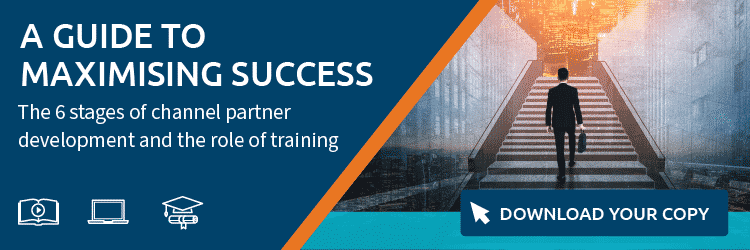One of the key strategies for growing a channel partner program is acquiring new partners. But how are you targeting those partners in the first place to ensure they are the right people to help drive your business forward?
The Benefits of Acquiring New Channel Partners
Acquiring more channel partners means more management, but it also equates to more revenue, especially if they are onboarded and trained in the best way possible to improve their sales effectiveness.
Having more partners reduces the impact of losing partners because you are less reliant on the same few distributors or resellers. No one is immune to market volatility, and the chance of even your most reliable partners going out of business is never zero, but expanding your network mitigates how detrimental the loss of a key partner can be.
A bigger network will also afford you new opportunities, either through taking advantage of new partners’ existing leads or because your new partners might be better placed to enter new markets, which is another key strategy for growth itself.
There’s no doubting the benefits of growing your network by acquiring new channel partners, but you want to enlist the channel partners that will be the most effective and the biggest asset to your business. So what are the most impactful steps you can take to target them?
You don’t just have to sell to more partners, growth can also be gained through encouraging all partners to sell more.
Start By Targeting Companies
Begin by looking at the target companies you want to partner with rather than the individuals within those partners. There are fewer companies than personas, and it is the easiest discovery method. This will help you filter your results from the beginning and prevent wasting time on unsuitable partners.
It is essential that you understand the companies that you target to ensure that they can provide the right partnership for your business by asking the following questions:
- Is the industry they work in a good fit for your business objectives?
- Do they cover multiple regions?
- Would the region they operate in allow you to enter new markets easily?
- What revenue would these companies need to make a partnership worthwhile?
- How many employees do they have?
- What is their capacity for growth?
Think not only about how this information can help you, but also how you can help to address any pain points for your potential partner. Each company will also have triggers that will inform your messaging when you make contact with them.
They might be fast-growing companies that can leverage the partnership with you, they might be stagnating and need to generate more revenue from their existing customer base, or they might be a newly-acquired company and their needs have shifted as a result.
Using all this information allows you to create targeted searches on platforms such as LinkedIn, filtering your list of targets significantly so you can move your search on to specific personas.
Next, Target Your Ideal Personas
When looking at who to target within your potential partners with your partnership proposition, consider the roles you want to target. Often, this will be directors.
Don’t just look at job titles and years of experience, but also how long they have been in the business. For example, if they have started in the last three months, they may need to make an impression, and partnering with you might be the solution. Again, this comes back to the messaging you use when you make them an offer.
It’s also important to understand their background, activities, goals, and character traits, as this helps to understand their pain points and create the right messaging so you can win their attention over other companies that also try to partner with them.
Consider also that these personas might not be problem-aware. Demonstrating your insight by pinpointing specific problems and articulating effective solutions positions you as invaluable. Such a proactive approach showcases your ability to add value, making you an ideal choice for meeting business objectives.
Create a Journey Map
Chart your partner journey from when your potential partners first become aware of your brand to the point where they are established, growing their business by selling your products.
Stages of the partner journey to map:
- Becoming brand aware
- Joining your program
- Selling your products
- Growing their business with you
This journey map is more than just a list of phases, it helps you determine key touch points and interactions at each stage, and it allows you to align your messaging and marketing with their needs and pain points.
To inform your journey map, you can gather feedback from your existing partners, and use your persona research and analytics to create a data-driven journey map.
Your partner journey map also helps establish your expectations and responsibilities to each other, helping both you and your potential partners know whether your goals are aligned before you commit to the partnership – a useful tool for keeping your relationship on track going forward.

Tools to Support Your Targeting
All of the research you have carried out in the discovery phase should have presented a clear picture of the potential partners you need to reach out to, beyond just their position in the company.
Use your journey map to address individual pain points and business goals to inform the language you use when connecting with your targeted partner for the first time. There are a few ways you can initiate contact:
LinkedIn is a great platform for creating targeted searches and getting in front of the exact right people. LinkedIn also allows you to send direct messages to your targets and not get sent to spam. Once you have connected with them, it also exposes them to the posts and educational content you post, helping to showcase your value and make your offer more enticing.
Not everyone is active on LinkedIn, so email is another important method of communication. (be aware that when cold-calling via email, use multiple domains so your company domain does not go to spam because too many emails are sent from the same domain). You will also need to consider the length of the email so that you don’t get marked as promotional spam.
Phone
Phone conversations allow direct communication with your targets and establish a relationship from the start. You can have more nuanced, intricate conversations, they can hear your voice, and you don’t have to wait for feedback, all resulting in a more personal connection than you would create from LinkedIn or email. However, for phone conversations to work, you will need the right script and access to direct mobile numbers for your potential partners, not just their office numbers.
Exhibitions
In addition to these direct contact methods, you can network with vendors and partners at industry-relevant exhibitions. At these events, you will have an audience containing the partner personas you have identified in your research. Also, companies often exhibit at these events with a view to meeting potential partners, meaning you won’t have to convince them of the benefits or need for a partnership, only that you are the right choice of partner.
You should contact each potential partner through different mediums to have the best chance of reaching them while allowing them to respond to you in their preferred format.
Crafting the Offer
With all the information you have gathered about your desired channel partners, you can craft your offer to them. Depending on where they are in their journey, you can use your partner map to tailor your offer to their exact needs. Your primary goal will be getting them to be your partner and sell your products, but this needs to happen in the right way that aligns with your brand.
Achieving this level of partnership also comes from training and education, which should be outlined in your offer. This education can be given through case studies, webinars, groups and communities, as well as by giving them access to learning platforms that help educate them to a higher level.
You can also sell additional training to your partners. Success is mutually beneficial, and their ability to move more of your products and represent your brand effectively offers them just as much potential reward as it does you. Partners paying for training should be seen as an investment that will result in a significant ROI.
Following these steps allows you to take a methodical approach to growing your partner network. Increasing the number of partners you work with is insufficient for long-term success if those partners are not aligned with your goals and are a good fit for your business. By spending time defining your ideal partners and understanding their individual situations, needs, and pain points, you can ensure that you establish the foundations for a lucrative partnership from the beginning.











